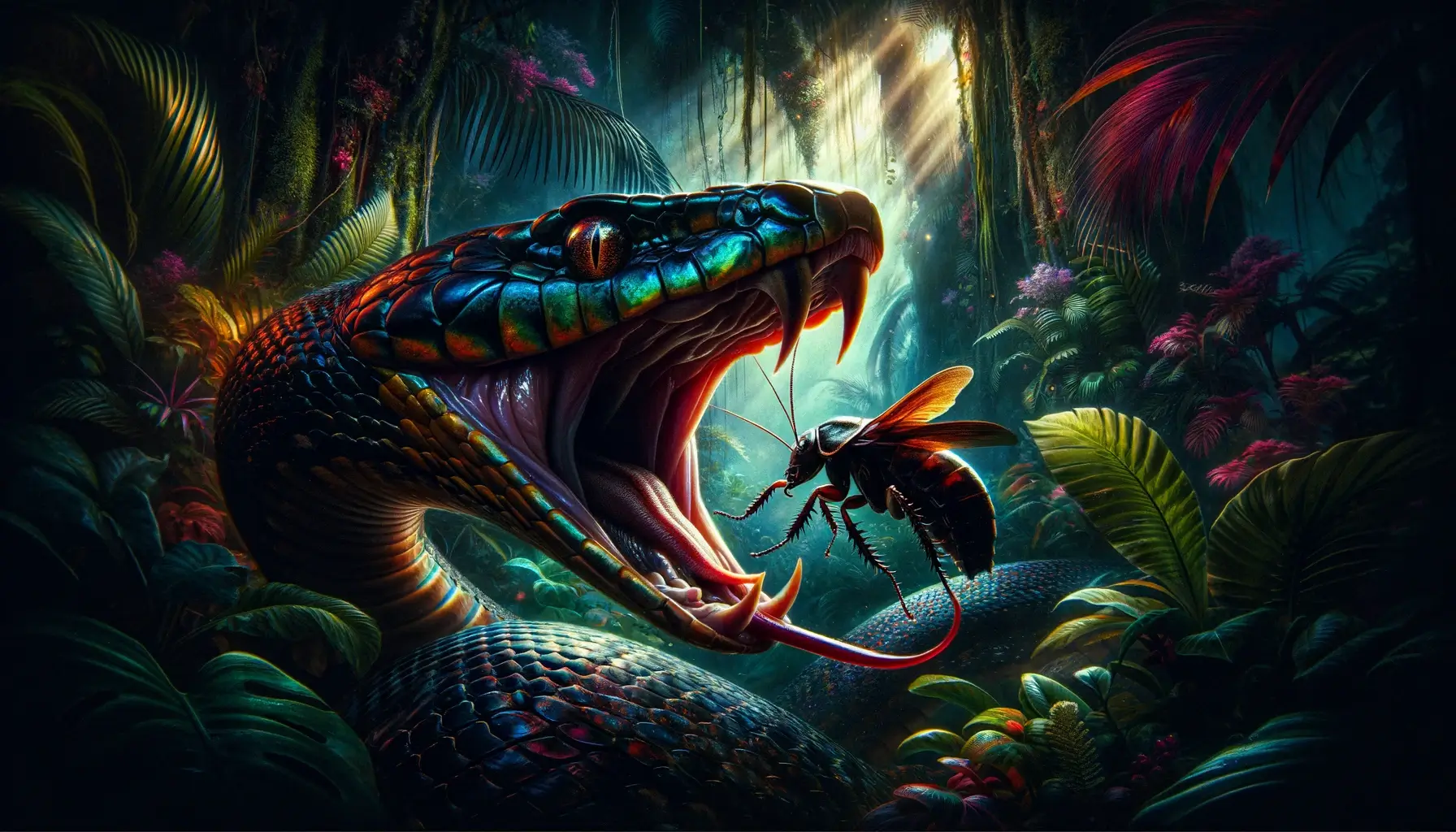Imagine you’re a snake slithering through the undergrowth, your senses honed in on your next meal. You come across a scuttling cockroach, its armor-like exoskeleton glinting in the dappled sunlight. Now, imagine this: you’ve likely assumed that this roach would make a perfect bite-sized snack for our hypothetical snake. But does the reality of a snake’s diet align with our assumptions? Do snakes, as a matter of fact, include cockroaches in their culinary repertoire? There’s more to this than you might think, and it could change your understanding of these fascinating creatures.
Understanding Snake Dietary Patterns
While you might assume that all snakes have similar dietary patterns, it’s crucial to understand that their diets can vary significantly based on factors such as species, size, habitat, and prey availability. For instance, larger snakes like pythons and boa constrictors often prey on larger animals such as rodents, birds, and even mammals. On the other hand, smaller species like garter snakes have a diet consisting primarily of insects, including cockroaches.
However, just because a snake can eat something doesn’t mean it will. Prey availability plays a significant role in a snake’s diet. If a cockroach is readily available and the snake is hungry, it’ll likely eat it. But if a snake is in an environment where cockroaches are scarce, it’ll adjust its diet accordingly.
Understanding these dietary patterns isn’t just for academic interest. It’s key to ensuring freedom for both snakes and other creatures in their habitats. By respecting their dietary needs and availability, we can help maintain healthy ecosystems that serve all creatures, not just those we find appealing. This approach offers a more balanced, enlightened perspective on our interconnected world.
Cockroaches: A Nutritional Overview
Now, let’s turn our attention to the cockroach, a common prey for many snakes, and examine its nutritional profile. To understand why snakes might find cockroaches appealing, we need to delve into their nutritional makeup.
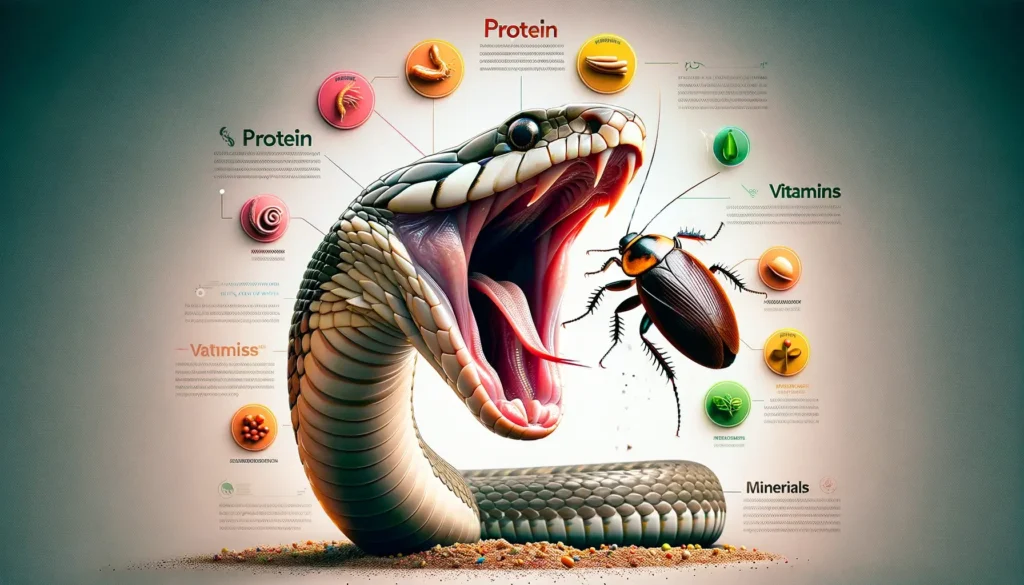
Cockroaches are rich in several key nutrients:
Protein: They’re high in protein, which is essential for the growth and repair of the snake’s tissues.
Fats: Cockroaches contain fats, which provide energy and help absorb vitamins.
Carbohydrates: Though snakes don’t need them in large amounts, carbohydrates can provide a quick energy boost.
Vitamins and Minerals: These are important for the overall health and well-being of the snake.
Fiber: This aids in digestion, although snakes don’t need much as they can’t digest it.
Snake Preferences: Insect Consumption
In a snake’s diverse diet, insect consumption, particularly of cockroaches, plays a crucial role due to their nutritional richness. You’ll find that snakes, being opportunistic feeders, capitalize on the abundance and availability of these insects in their environment. And it’s not just about accessibility; cockroaches provide a balanced blend of proteins, fats, and carbohydrates, essential for a snake’s growth and overall health.
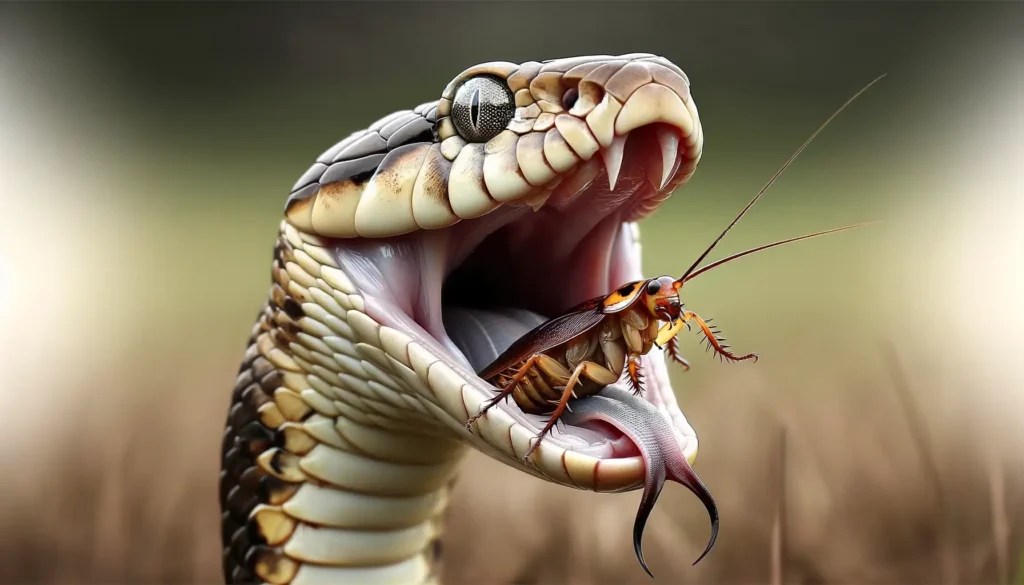
However, not all snakes will willingly devour cockroaches. There’s a distinct preference based on the snake’s species, size, and habitat. For instance, smaller species like the garter snake are more inclined to consume insects, while larger constrictors like pythons and boas lean towards larger prey. But it’s not a rigid rule. Some snakes, regardless of their size, may display a preference for insects due to learned behavior or environmental influences.
Do Snakes Consume Cockroaches?
Feasting on cockroaches, certain snake species have adapted to incorporate these insects into their regular diet. Which species are we referring to? Well, it’s typically the smaller ones, especially those found in urban settings. They’ve evolved to exploit the abundant supply of cockroaches in these areas.
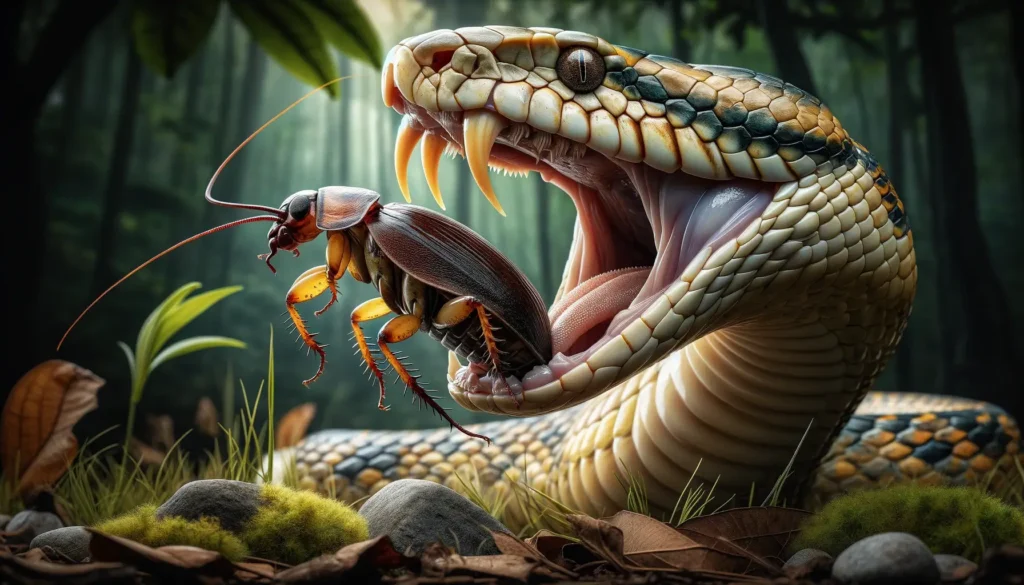
Let’s delve deeper into this:
- Garter snakes: They’re partial to cockroaches and will eagerly devour them when available.
- Corn snakes: Known for their adaptability, they’re not opposed to a cockroach meal.
- Milk snakes: They’re opportunistic, consuming cockroaches if they cross their path.
- King snakes: Like their fellow species, they’ll consume cockroaches, albeit less frequently.
- Rat snakes: Despite their name, they’ll happily consume cockroaches, along with their regular diet of rats.
The act of consuming cockroaches isn’t just because they’re available. It’s also due to their high protein content, which is beneficial for the snake’s growth and metabolism. So, in essence, cockroaches serve as a quick, nutritious snack for these snakes. By understanding this, you’re free to appreciate the complex and adaptable nature of these fascinating creatures.
Factors Affecting Snake’s Food Choices
While it’s clear that certain snakes enjoy a cockroach snack, it’s crucial to realize that a variety of factors influence these slithering predators’ dietary preferences. You might think it’s as simple as what is available in their environment, but it’s actually much more complex.
One key factor is the snake’s size. Larger snakes are capable of consuming larger prey, while smaller snakes must stick to smaller meals. A snake’s body size also determines their ability to open their mouth wide enough to swallow certain prey. For instance, a king cobra could consume a rat, but a garter snake couldn’t manage such a feast.
Another influencing factor is the snake’s metabolic rate. Snakes are ectothermic, meaning their body temperature is dependent on their environment. Cold environments slow their metabolism, reducing the need for food. Conversely, warm environments quicken their metabolism, increasing their appetite.
Lastly, the snake’s habitat plays a role. Snakes living near water tend to consume aquatic creatures, while those in forested areas might prefer birds or rodents. So, while cockroaches can be part of a snake’s diet, remember that their food choices hinge on various factors.
Do Snakes Eat Cockroaches
Delving into the question, ‘Do snakes eat cockroaches?’, you’ll find that the answer isn’t as straightforward as it might seem. While it’s true that snakes are predatory creatures, they’re also quite selective. Some species of snakes do indeed eat cockroaches, but not all. Factors such as size, location, and snake species can greatly influence this.
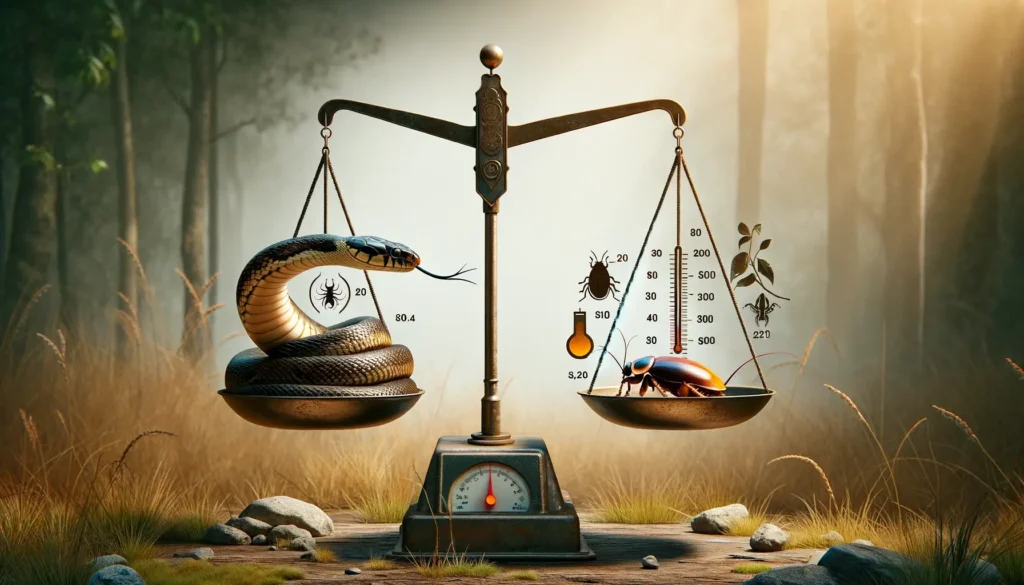
To better understand, consider the following:
Some smaller snake species, such as the DeKay’s brown snake, are known to consume cockroaches. Their small size makes cockroaches an easy prey.
Larger snakes, like pythons or boas, usually prefer larger prey. A tiny cockroach wouldn’t satisfy their hunger.
Geographic location plays a part, too. In regions where cockroaches are abundant, snakes might consider them a convenient food source.
Certain snakes have evolved to prefer specific prey, which may or may not include cockroaches.
Lastly, the availability and ease of catching a cockroach influence a snake’s choice.
What Animal Eats Cockroaches
Contrary to what you might think, snakes aren’t the only animals that find cockroaches to be a palatable meal; in fact, a surprising variety of creatures include these insects in their diet. Let’s embark on a fascinating journey of exploring this ecological food chain.
Predominantly, birds such as chickens and turkeys have been observed consuming cockroaches when provided the opportunity. Amphibians, especially frogs and toads, also consider these critters a delicacy. Even certain mammals like hedgehogs and armadillos are known to feast on them.
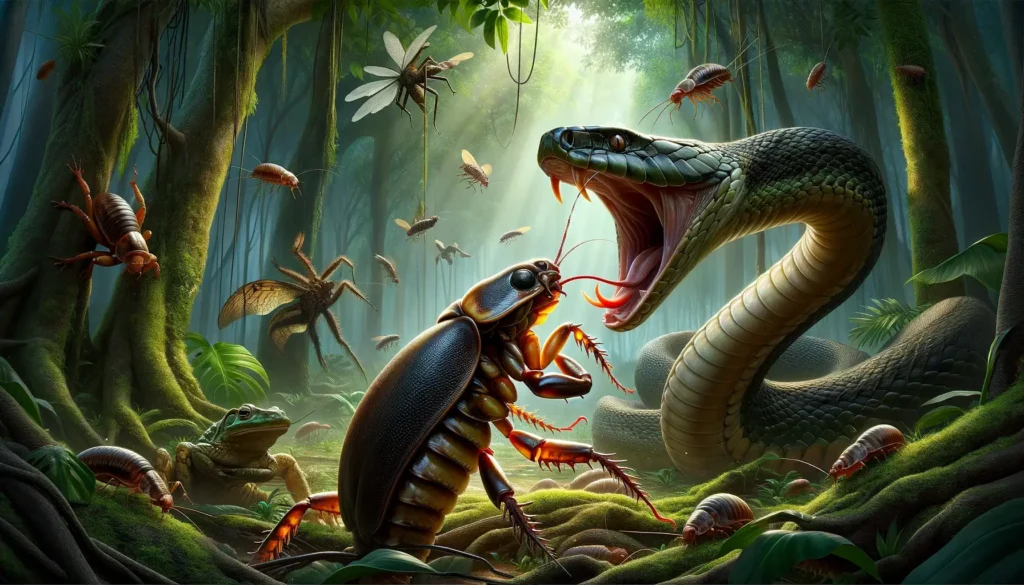
In the insect world, even cockroaches aren’t immune to cannibalism; larger species often prey on smaller ones. Moreover, certain species of ants, spiders, and beetles are natural predators of cockroaches.
In aquatic ecosystems, fish such as Oscar, Arowana, and Catfish are known to eat cockroaches, demonstrating the wide range of environments in which cockroach predation occurs.
Lastly, it’s worth mentioning that numerous species of parasitic wasps lay their eggs on or inside cockroaches, providing their larvae with a fresh meal upon hatching.
Implications for Ecosystem Balance
Given this vast array of cockroach predators, you can start to appreciate the pivotal role these insects play in maintaining the balance of various ecosystems. Cockroaches, as a food source, are integral to the survival of many species, including snakes. The disruption of their population can have far-reaching consequences that may not be immediately evident.
Consider the following potential implications:
- If the cockroach population dwindles, predators may struggle to find sufficient food, leading to a decrease in their numbers.
- This decrease in predator numbers could allow for the overgrowth of other prey species, leading to an imbalance.
- On the other hand, an increase in cockroaches could result in a population boom for certain predators, again disrupting the balance.
- Changes in predator and prey numbers can impact plant life, as some species may lose their pollinators or seed dispersers.
- Lastly, the cockroach’s role as a decomposer, breaking down dead organic material, contributes to soil health.
In essence, even a seemingly insignificant insect such as the cockroach plays an indispensable part in the tapestry of life. You’re reminded that every organism, regardless of size or reputation, is crucial for the overall health and freedom of our planet’s ecosystems.

